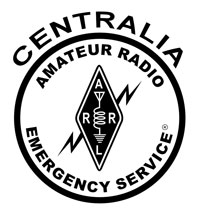
It was a typical Northwest day with 100% chance of rain all day accompanied by 12 mph winds. But we don’t care! We are Professional Amateur Radio Emergency Service Volunteers! We laugh at bad weather, especially when we can use our two communications vans equipped with superb heaters. These regular 3 hour monthly field communications test exercises are fun and each one is a learning experience. We have three objectives: provide orientation on the vans and communications equipment to any of our team that wish to learn; test communications capabilities throughout our response area HT up to HF; and check into the monthly FEMA and Homeland Security nets in support of our State EOC tests.
We began this exercise with another van deployment orientation – basically making sure everyone knew how to take the comm vans out of the fire station where they are housed. This involves unplugging the external power systems, unplugging the battery tender, raising the fire station doors and start up procedures for the vans. We also spent some time showing everyone how to set up the Icom IC-7300 radios for CW operations as that would be part of the exercise parameters for the day. Once out of the station, one van was deployed to Riverside Fire Station number three and the other would go to RFA station number 4 – both on the outskirts of our response areas. When the vans were in place and the HF antennas up, we were ready to conduct some communications tests.
This exercise began testing our CW capability on the 6 meter simplex frequency. We successfully passed CW traffic back and forth between locations using short messages at different speeds. From there we moved on to testing voice comms over the same 6 meter frequency. On testing days, we always have a couple of team members monitoring from home just to give us a little more information about how well things are working. While we regularly use our two local repeaters for these tests, we have learned that 6 meters (simplex and repeater) works well enhancing our capabilities.
Next were the VHF/UHF tests over three area wide repeaters as well as our two local repeaters. All worked well. We have found through testing that one repeater north of our response area does a really good job covering a couple of areas our local repeaters have trouble with. Thanks to the Capitol Peak Repeater folks for letting use their repeater.
One area we continually want to test is our ability to use 5 watt HTs within our response area. Should the worst happen, these radios may be our last line of defense but we need to have a through understanding of their limitations and where they will and will not work. Should we be tasked with house to house evacuations in outlying areas, we will need to rely on volunteers using HTs to pass information. If necessary, we can and will use relays to make the communications happen. While this worked well from one fire station, the other had difficulties as we were working under a power line and up against a metal building but choices were limited. Our goal is to create a response area wide map that shows where HTs will function reliably. While we have options, it is important to know what communications systems work and where they don’t. Unfortunately, our response area is not flat where line of site comms work well. We are surrounded by hills, mountains and plenty of dirt.
Each Field Communications Test Exercise provides a little more data and plenty of opportunity to use all the radio systems in the comm vans. What will we be testing next month? We will have to wait to decide but we have an extensive list of ideas to try. Maybe next month will be warmer and dryer, but we don’t mind a little bad weather. Did I mention how well those heaters work in the vans?

